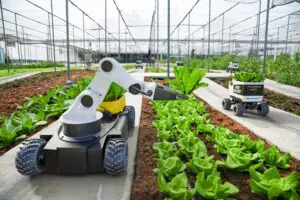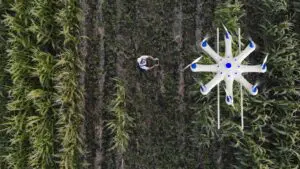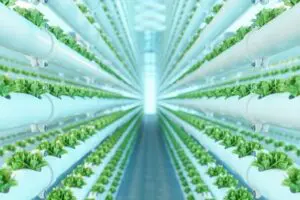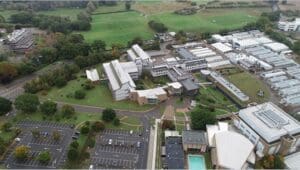Current trends and technologies in the UK Agricultural Technology industry
Agriculture is a sector under increasing pressure; technology is increasingly turned to as the solution.
The list of external factors that have impacted the agriculture sector is both well-known and long. With the global population predicted to reach 9.7 billion by 2050, population growth will increasingly occur in regions that will struggle to grow food sustainably. Agri-Tech has to be a large part of the solution.
Agri-Tech encompasses a large range of technologies, including robotics, software, biotechnology, information monitoring, and data analysis, that can be implemented to improve efficiency, reduce costs, increase yield, and bolster sustainability. This is a compelling blend of solutions, but they face resistance from costs, industry adoption, and reliability.
Government assistance for UK Agri-Tech
As this is written at the end of July 2024. The Labour manifesto and Kings Speech were light on detail on farming, with it is only mentioned five times in the manifesto itself and never in the context of funding support. The King’s Speech set out that food was a national security matter, but the detail of the legislative agenda is unclear.
The past UK Government had taken some steps help facilitate the advancement of Agri-Tech by offering financial assistance to both developers and adopters of this technology. Through DEFRA (Department for Environment, Food & Rural Affairs), there are several grants available to assist in the adoption and advancement of Agri-Tech products, though we note the pools of funding are disappointingly low:
- Round 2 of the Improving Farm Productivity grant, which is to be used for innovative farming equipment that will increase productivity and improve the environment. The maximum offer is £500k, with £25k-£500k available for robotic and automated equipment and systems, and £15k-£100k available for solar equipment.
- Round 3 of the Farming Innovation Programme – Large R&D Partnerships will provide grants, worth a share of £7.8m, focused on funding businesses to further develop a new farming product or service towards commercialisation. It will be aimed towards growers and foresters in England who want to take forward concepts looking to improve productivity, sustainability, resilience, and to help the sector on its path to net zero.
- Grants apart of the Farming Innovation Programme – Farming Futures R&D – nutrient management will be providing funding for businesses and researchers to work on longer-term innovation. As the name suggests, these grants are for those focused on nutrient management. Those successful in applying will receive a share of up to £25m, which will be delivered across two competition rounds.
- Farming Innovation Programme Fund: Accelerating Development of Practices and Technologies (ADOPT) will be giving out grants whose aim is to support groups of farmers, growers, and foresters in England with conducting on-farm experiments and trials, helping to de-risk farmers’ participation in research and innovation. Farmers will be able to drive relevant practical research and to provide “pull-through” of new technologies and processes to the practical domain. In total, £43m of grant funding will be available up to 2028/29.
- Round 4 of the Farming Innovation Programme – Small R&D Partnerships is designed to assist businesses in developing a new farming product or service and then carrying it towards commercialisation. The grants from this round, which will be a share of £7.8m, can also be used to develop a solution once it works in practice.
- Grants from round 4 of the Farming Innovation Programme – Feasibility Studies will provide funding to be used to test the feasibility of early-stage solutions, and to make informed decisions on subsequent larger scale R&D projects. Those interested can apply for a share of up to £4.8m.
- Farming Innovation Programme – Farming Futures R&D – Net Zero Farming consists of grants for businesses and researchers to have the needed funding to work on longer-term innovation. The focus of this competition is net zero farming, with applicants able to apply for a share of up to £12.5m.
Investment in the UK Agri-Tech space
In the absence of seeing where the next Parliament could go in regard to funding Agri-Tech, we turn to private sector funding.
Source: Pitchbook
Venture capital and private equity investment into the UK Agri-Tech sector shows an interesting picture, with there being no clear upwards or downwards trend in both capital invested and deal numbers over the past seven years. An important note for this chart is that 2022 is massively skewed by a deal worth £1bn by Caledonia’s investment in Croda International therefore, while the level of funding in 2022 still remains above that of 2023, it is not as drastic a difference.
What this chart, and the analysis above, shows is that there is no real critical mass of capital invested into UK Agri-Tech businesses in terms of value. We suspect this means that the UK does not have enough private capital coming into our own businesses to be a sustainable world leader in the sector. The potential is clearly there but, with consistent volume numbers from 2018 to 2022 one would expect to see the total capital invested tracking up at a faster gradient than the deal volume. Disappointingly, it is falling. On the other hand, the median deal size has been on an upwards trajectory since 2020, suggesting that select companies are able to attract more investment.
Once full year 2024 data become available, it will be interesting to see whether this funding landscape will improve in terms of total capital invested, or if only select companies will continue to attract higher levels of investment. As of now, 2024 has some catching-up to do in the latter half of this year if we are to at least see similar levels of investment as 2023.
Exciting new trends & technologies in Agri-Tech
The move towards renewable technology
With the UK Government’s ambitious goal of reaching net zero emissions by 2050 approaching, and an influx in the use of renewable agricultural technology, UK Agri-Tech has the capacity to respond. This is furthered by the National Farmers Union’s (NFU’s) ambition to reach net zero by 2040 through encouraging and supporting landowners to improve efficiency, land management, and altering land use to capture a higher quantity of carbon.
The adoption of renewable Agri-Tech is on the rise as the extensive benefits of renewable Agri-Tech such as reducing the consumption of water, nutrients, and fertiliser, in addition to reducing the impact on the ecosystem, become more widely known. Further advantages include greater efficiency, lower prices, and a higher level of sustainability for businesses.
According to a survey conducted on behalf of the UK Agri-Tech Centre, the second highest priority for agri-food business leaders is becoming more sustainable, with sustainable production being identified as a key priority by 40% of leaders across agriculture and food industries businesses. In the same line, food security (38%) and resilient food systems (31%) were also named as being key priorities.
In the same survey, decision-makers across agriculture and food industries identified food security and adapting to climate change as the biggest challenges for the next five years, each with 15% of responses. They were followed by sustainability (14%), carbon/greenhouse gas emissions (13%), and labour availability (12%). Therefore, climate change, achieving sustainability, and net zero related issues are of clear concern.
Innovation in Agri-Tech is centred around these challenges, helping agriculture to become more sustainable and efficient while also improving farmer’s quality of life/work. Below, we have highlighted certain areas of Agri-Tech that are of particular interest in order to show the breadth of which the sector has to offer.
Agricultural robotics

The implementation of robotics technology in the agricultural sector is ground-breaking given the critical issue of labour shortages for the industry. Repetitive field chores that robots can automate include fruit picking, planting, transplanting, harvesting, seeding, spraying, and weeding. Examples of intelligent agricultural machinery include autonomous and semi-autonomous tractors equipped with auto-steer technology that streamline harvesting and navigation. Other applications of robotics in agriculture include automated livestock management systems that are able to manage tasks like weighing, incubation, milking, and feeding.
There are several advantages of integrating robotics into a farm’s operations, such as enhancing overall productivity with the added benefit of reducing human error, reducing waste on the farm caused by labour shortages, and improving the farm’s efficiency.
Near the end of 2023, it was announced that nineteen innovative projects focused on developing robotic and automation technologies would receive a share of £12.5m in government funding, through the Farming Futures Automation and Robotics competition, with the intention to boost productivity, food security and sustainable farming practices. Projects that won a share of the funding include:
- The development of a system able to accurately predict and enhance the quality of strawberry yields, which will reduce waste from the harvests, and optimise labour and harvesting schedules.
- A system that is able to digitally map and monitor vineyards using robots, drones, and sensors.
- A navigation system for field-based robotic vehicles that will improve accuracy and reliability, while also enabling safe navigation in farmyard and field operations.
Artificial Intelligence (AI), Machine Learning (ML) & Drones

AI presents vast transformative potential for the UK agricultural sector. The application of AI technology offers significant scope to increase efficiency through its powerful predictive capabilities for weather data, prices, and crop yield, to support well informed critical decisions for farmers.
The solutions offered through AI can be grouped into the following disruptive categories, Detection, Diagnosis, Determination, and Delivery.
- Detection involves the employment of various techniques including image processing, soil nutrient monitoring as well as crop and animal health scanning to detect issues undetectable to the human eye. UK start-up DroneAg provides cutting edge drone technology offering automation of data collection and analysis as well as real time remote data transfer for farmers. In summary, through geo-mapping and livestock scanning, detection orientated AI provides the potential benefits of cost minimisation as well as productivity optimisation for farms through spotting critical issues early.
- Diagnosis entails the application of advanced data analytics using a variety of data inputs to provide real time solutions to complex issues. This includes the use of telemetric tools to allow for issue diagnosis of equipment & stock. In doing so, this potentially reduces the length of output-hindering issues, whilst allowing for timely identification of equipment and stock problems. Diagnosis AI may help maximise farm output as well as streamlining productive efficiency.
- Determination offers powerful problem-solving capabilities to complex issues allowing for the potential future outsourcing of decisions for farmers. ML can assist in the management of crops, such as detecting diseases and predicting yields, water, including predicting water usage and monitoring soil water, soil, such as managing pesticides and fertilisers, and livestock, including monitoring animal welfare and aiding in precision livestock farming.
- Closely linked to the area of robotics visited above, delivery provides the potential to mitigate labour shortages through the provision of automated solutions to complex and precise tasks previously requiring manual involvement. Unfortunately, a current fundamentally limiting hurdle for scaled agricultural adoption of AI is the high set up costs particularly for smaller farms susceptible to annual turnover volatility. Successfully climbing this cost hurdle may help farms reduce labour needs and in turn wage costs whilst creating greater time availability to be allocated to remaining manual needs.
Vertical farming

A significant supply chain disruptor for Agri-Tech is the adoption of vertical farming. This involves the process of growing crops vertically on shelves to take advantage of all space available in a three-dimensional area whilst providing consistent and optimised conditions. Vertical farming enables plant growth in layers; increasing productivity whilst reducing wastage, not to mention the added protection from volatile weather conditions.
The environmental benefits are compelling as the nutrient rich water soaking the plant’s roots is re-used up to 30 times, reducing water usage by 95% and eliminating the runoff of herbicides and pesticides. A restrictive underlying factor in terms of commercial viability for vertical farming, however, is the energy intensive requirements of indoor farming. Although, when paired with renewable energy (as many vertical farms are starting to introduce), the potential for advance in sustainability is significant.
Vertical farming has faced many challenges over the past few years, with some companies not making it through to the other side. These challenges include rising energy costs, the COVID-19 pandemic, cost of living crisis, difficulties in raising funds, and financial overreach.
In addition, vertical farming is not without criticism. Industry experts are sceptical that vertical farming will be able to substantially meet the growing demand for food, as the crops grown in these systems are not the stable crops, such as grains, potatoes, and rice. What is grown in these systems, mainly leafy greens, are still seen as an almost premium product and they do not make up the majority of the food market. With that being said, we have first-hand experience of working on compelling vertical farming business models and recognise that it is possible to create value to all through this combined technology when the right funders are matched to the right assets, governed through the right business model.
Precision agriculture

Precision agriculture uses a range of technologies, such as GPS, drones, sensors, and data analytics, to maximise the quality and productivity of the overall yield while minimising the impact on the environment. As the agricultural landscape differs widely in terms of soil properties, sunlight exposure and slopes, uniform farm treatment is now outdated. The allocation of precise inputs in terms of fertilisers, pesticides, and water is critical to maximise productivity for farmers. Not only this, but precision agriculture can also assist farmers in making more informed decisions based on historical and real-time data, allowing them to adjust their practices to changing conditions. This give the benefit of enhancing the efficiency, profitability, and resilience of their practices.
The technological applications of precision agriculture are extensive, ranging from satellite systems for soil and geo-mapping, to accurately identifying geographical differences, through to variable rate technology to calculate the optimal allocation of farming inputs with gathered geographical data.
The growth of this section of Agri-Tech has been driven through agricultural income, business capital expenditure and the deprecation of the pound. However, it unfortunately continues to face a range of challenges:
- High cost and complexity of associated technology and infrastructure serves as a barrier hindering the adoption of agricultural technology.
- The need for farmers to invest in the necessary equipment, software, and training required for the use of precision agriculture tools, which may not be affordable or accessible for them.
- Volatile fertiliser prices have hindered demand for industry services, particularly for soil mapping and variable-rate application technology.
- Technological competition with vertical farming, which may present greater cost efficiency in maximising yields relative to precision farming methods that perform the same task.
- Potential issues with compatibility and data quality due to the lack of interoperability and standardisation among different devices and platforms.
Given the promising boost in efficiency offered through the wide range of precision agriculture technologies available, precision agriculture may be a useful development for UK Agri-Tech, provided the present hurdles of cost and complexity are overcome.
Agricultural biotechnology
Agricultural biotechnology (agri-biotech) provides the tools that can enhance crop and livestock quality. Scientific methods that fall under agri-biotech and enable the identification of desirable traits in plants include plant breeding, hybridisation (which is the process of breeding two different individuals of the same or other species in order to achieve the desired changes in the organisms), genetic engineering, and tissue culture. A notable example is CRISPR-Cas9, a genome editing technology, which provides precise and fast trait modification. The results of these biotech solutions are transgenic plants that exhibit drought and pest resistance, disease tolerance, and high yield potential, which in turn boosts farm profitability.
Other agri-biotech techniques at the forefront are eco-friendly solutions which are alternatives to common products used on farms. Examples include bioherbicides, biofertilizers, biopesticides, and bioplastics. These products help to address soil toxicity issues, with the added bonus of minimising the impact to the environment.

John Innes Centre in Norwich
An example of developments on-going in agri-biotech is the multidisciplinary research into crop resilience to help combat disease and increase yield, that is being carried out on the Norwich Research Park. A specific example of this research is the BBSRC’s (Biotechnology and Biological Sciences Research Council) Designing Future Wheat Institute Strategic Programme, whose researchers includes those at the John Innes Centre, Earlham Institute, and Quadram Institute. In total, the programme includes eight research institutes and universities, who are working in collaboration to develop new wheat germplasm, which is living genetic resources such as seeds or tissues, containing the next generation of key traits.
Challenges
The NFU’s Mutual Voice of The Farmer survey found that, in 2023, nearly a fifth of farmers had or planned to invest in Agri-Tech, an increase of 13% from the previous year. However, the same survey revealed that 62% of farmers have yet to consider new Agri-Tech.
The potential reasons behind this hesitation, according to a survey conducted on behalf of the UK Agri-Tech Centre, include the cost of purchasing the technology itself (named by 38% of respondents), the implementation cost of the technology (33%), insufficient knowledge and support (30%), and a lack of skills or training (29%). For a little over a quarter of businesses, the accessibility of the technology and the awareness of what Agri-Tech solution are currently available were also named as issues.
In addition, the same survey revealed that there are barriers for developing new technology as well. The biggest obstacle, named by 39% of respondents, was access to funding, followed by resource and time constraints (38%), the ability to attract investment (27%), and regulatory hurdles (26%).
Following these observations, there is a question of whether there is enough financial support available for both the developers and adopters of Agri-Tech, despite the range of grants offered by the UK Government. A need that seems apparent from this survey data is the investment into expanding the knowledge and training the relevant skills required to use Agri-Tech developments to their fullest potential.
Conclusions
Domestic and international politics has placed the agriculture sector in a difficult economic position. Farmers who have done all the right things are taking the economic risks for factors far beyond their control.
Technology offers long term opportunity, but government must do more to help those who have rubber on the ground be able to understand their long-term future, afford the technology, and be trained on how to use it effectively.
There is an opportunity for the UK to become a world leader in Agri-Tech and ‘win’ the double benefit of more efficient and sustainable food production, along with the economic benefits of UK shareholders and companies owning the technology itself. However, to get there, more critical mass is needed.
We look forward to seeing the Government understand and solve these challenges.
We always recommend that you seek advice from a suitably qualified adviser before taking any action. The information in this article only serves as a guide and no responsibility for loss occasioned by any person acting or refraining from action as a result of this material can be accepted by the authors or the firm.
Have a question about this post? Ask our team…
Sign up to receive exclusive business insights
Join our community of industry leaders and receive exclusive reports, early event access, and expert advice to stay ahead – all delivered straight to your inbox.
